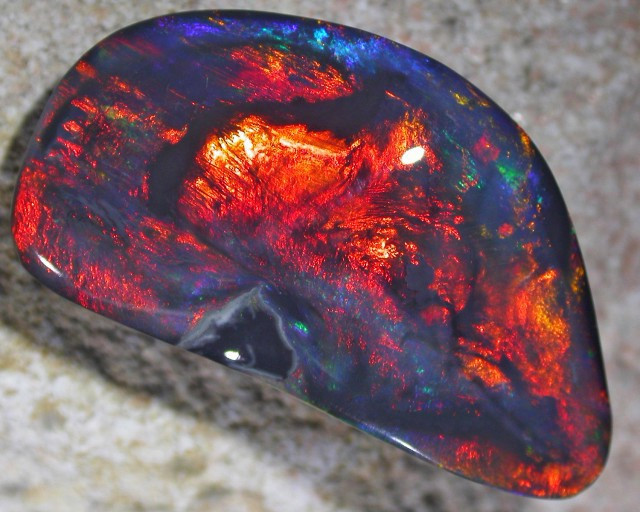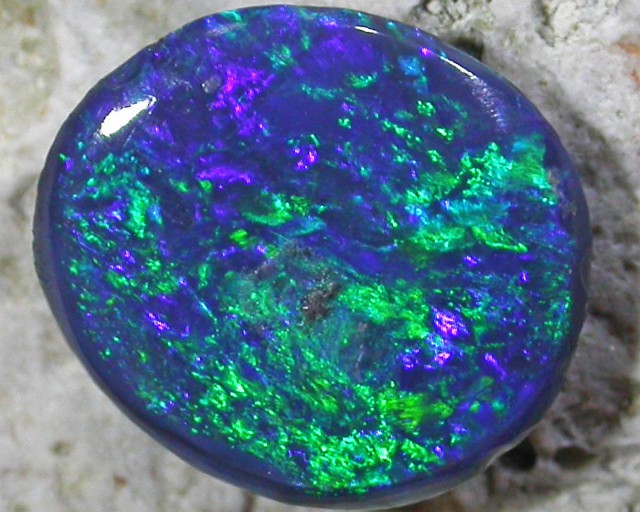
Veröffentlicht am 5th Sep 2019
Geändert am 17th Nov 2025
Welche Farbe hat Opal?
 Wenn Sie Opale lieben, sind Sie wahrscheinlich im Oktober geboren. Oder Sie haben einfach eine Vorliebe für die einzigartige und farbenfrohe Leuchtkraft von Opalen entwickelt.
Wenn Sie Opale lieben, sind Sie wahrscheinlich im Oktober geboren. Oder Sie haben einfach eine Vorliebe für die einzigartige und farbenfrohe Leuchtkraft von Opalen entwickelt.
Was macht Opale so besonders? Nun, ein einziger Opalstein kann ein ganzes Farbspektrum umfassen, die alle in einem auffälligen, opalisierenden Glanz erstrahlen, der einzigartig für Opale ist.
Vielleicht fragen Sie sich, warum Opale so farbenfroh sind und welche Farbe sie genau haben. Mehrere Faktoren tragen zu dem einzigartigen Farbspektrum bei, das ein Opalstein ausstrahlt. Um dieses Naturwunder vollständig zu erklären, müssen wir jedoch zunächst einige wissenschaftliche Begriffe definieren.
Keine Sorge, wir werden nicht zu technisch, aber wir werden Ihnen gerade genug Informationen geben, um Ihnen zu helfen, die Prozesse, die für die farbenprächtige Vielfalt der Opale verantwortlich sind, vollständig zu verstehen.
Was ist ein Opal?
Ein Opal ist ein amorpher, also formloser Stein aus Siliziumdioxid. Sein Inneres besteht aus winzigen, geordneten Kügelchen, die in einer gleichmäßigen und geordneten Anordnung angeordnet sind. Wenn Licht diese Kügelchen durchdringt und auf das Siliziumdioxid trifft, wird es gebrochen und emittiert ein breites Farbspektrum.
Opale sind der Geburtsstein für Oktober und symbolisieren Hoffnung, Reinheit und Glück. Diese atemberaubenden Steine sind berühmt für ihr Farbenspiel, da sie blitzschnell von hellen, schimmernden Farben zu intensiven, leuchtenden Feuerfarben wechseln können.
Per Definition bedeutet das Wort „Opal“, einen Farbwechsel zu beobachten. Im Folgenden erläutern wir die wissenschaftlichen Grundlagen und die Fachbegriffe, die erklären, warum Opale so stark ihre Farbe verändern. 
Was ist Beugung?
Wenn Licht in mehrere Bänder aufgespalten wird, können helle, dunkle oder farbige Bänder entstehen. Bei Opalen erzeugt die Beugung ein breites Spektrum an leuchtenden Farben, von blassen Grautönen bis hin zu intensivem Blau und feurigem Rot.
Was ist Ablenkung?
Wenn Licht durch ein Objekt dringt und gebrochen wird, ändert es seinen Weg von der geraden Linie. Diese Ablenkung beeinflusst das sichtbare Lichtspektrum und ermöglicht es unseren Augen, die komplexe Vielfalt der schillernden Farben eines Opals wahrzunehmen.
Was ist Opaleszenz?
Nur wenige Steine haben einen eigenen Fachbegriff, der ihr einzigartiges Aussehen beschreibt. Ein Grund für die Besonderheit von Opalen ist ihre Opaleszenz. Kurz gesagt, bezeichnet Opaleszenz den optischen Effekt, der durch die einzigartige Anordnung der Merkmale eines Opals entsteht: Glanz, Farbe, Schimmer, Leuchten und Irisieren. Die Begriffe Opaleszenz und Irisieren werden oft synonym verwendet, wobei Opaleszenz jedoch direkt dem Opalstein zugeschrieben wird.
Wie Ablenkung und Beugung die Farbe von Opalen beeinflussen
Die Größe der Kügelchen im Inneren eines Opals beeinflusst, welche Farben wir sehen. Das Licht, das durch einen Opal fällt, wird zunächst abgelenkt, dann gebeugt und schließlich in seine Bestandteile zerlegt. Der Grund für das schillernde und mehrfarbige Erscheinungsbild des Opals liegt darin, dass beim Bewegen des Steins das Licht in unterschiedlichen Winkeln auf verschiedene Kügelchen im Inneren trifft und so eine Vielzahl einzigartiger Farben erzeugt. Dadurch scheint sich die Farbe des Opals ständig zu verändern.
Aus diesem Grund lässt sich die Farbe eines Opals nicht immer eindeutig bestimmen, da er mehrere Farben enthält. Egal, wie man einen Opal neigt oder dreht, er reflektiert jedes Mal andere Farben. Deshalb sind Opale so attraktive Schmucksteine. Während einfarbige Steine gut mit anderen Farben harmonieren, vereinen Opale Farben aus dem gesamten Farbspektrum und sind somit ausdrucksstarke Schmuckstücke. 
Weitere Faktoren, die die Opalfarbe beeinflussen
So wie verschiedene Blickwinkel beim Betrachten eines Opals unterschiedliche Farben offenbaren, bestimmt auch die Größe des Steins seine Farbe. Deshalb ist es so schwierig, Opal als einheitliche Farbe zu definieren. Es gibt jedoch einige Faustregeln.
- Große Opale in runder und ovaler Form zeigen warme Rottöne.
- Kleine Opalsteine wirken kühl und strahlen überwiegend blaue und grüne Farbtöne aus.
- Intensiv gefärbte Steine sind ein Hinweis darauf, dass die Silikatstruktur im Inneren des Steins einheitlich ist.
Opalarten
Wie Sie inzwischen sicher bemerkt haben, ist es schwierig, die enorme Farbvielfalt eines Opals mit nur einer Farbe zu beschreiben. Dennoch lassen sich Opale in verschiedene Kategorien einteilen. Hier ein Überblick über einige der beliebtesten und einzigartigsten Opale:
- Weiße Opale besitzen eine weiße, milchig-weiße Grundfarbe und strahlen dennoch ein wunderschönes Pastellfarbenspektrum aus.
- Schwarze Opale haben eine dunkle Grundfarbe und reflektieren überwiegend blaue, grüne und graue Töne.
- Feueropale enthalten Funken von intensiven, feurigen Farben, darunter Rot, Orange und Gelb.
- Kristallopale sind nahezu transparent und reflektieren helle und klar definierte Farben.
- Blaue Opale reichen von Hellgrau über Aquamarin und Türkis bis hin zu Tiefblau und weisen Adern in sandigen, orangen und milchigen Erdtönen auf.
- Rosa Opale haben einen pfirsichfarbenen bis lachsfarbenen Farbton und sind mit schwarzen und tieforangefarbenen Sprenkeln durchzogen.
- Kristallopale sind Kristallopale mit einer rauen Struktur und leuchtenden, neonartigen Farben.
- Dreifarbige Opale sind extrem selten und erscheinen überwiegend silbern oder rosa mit einem weichen, seidenmatten Glanz. Die Farbgebung dieser einzigartigen Opale erinnert an gefrorenes Eis.
Wie werden Opale in Schmuck verwendet?
Rohe Opalsteine eignen sich hervorragend für einzigartige Schmuckstücke. Opale zieren wunderschöne Halskettenanhänger, Ringmittelsteine und Akzentsteine sowie Halsketten und Ohrringe. Das Besondere an Opalen ist ihre Vielfalt an Formen und Farben. So können Sie Ihren Schmuck individuell gestalten und aus einer breiten Palette an Stilen wählen. 
Opale werden oft in einzigartige Formen geschliffen, darunter Herzen, Dreiecke, Rechtecke und sogar Tierformen wie Delfine und Schildkröten. Juweliere kombinieren Opale auch mit anderen Steinen wie Lapislazuli und Labradorit, um ein einzigartiges, farbenfrohes Schmuckstück zu kreieren.
Ob als passendes Ohrring-Set, als einzigartiger Edelsteinanhänger oder funkelnder Ring – Opale gehören zu den vielseitigsten und außergewöhnlichsten Geschenken der Natur. Wer die ganze Farbenpracht des Regenbogens in einem einzigen Stein vereinen möchte, trifft mit Opalen die perfekte Wahl.
OPALE KAUFEN
Suche nach Opal Encyclopedia
Verwandte Auktionen
In Verbindung stehende Artikel
Opal-Intarsien sind eine Technik, bei der dünne Opalsplitter in Schmuckstücken verwendet werden, um ein schönes und interessantes Muster zu erzeugen. Erfahren Sie, wie sie hergestellt werden und wie man sie pflegt.
17th Jul 2018
Welcher Opalanhänger gefällt Ihnen am besten?
5th Mar 2019
Neue Artikel
Schwarze Opale sind die begehrteste Opalart. Ihre tiefe Basis erzeugt ein regenbogenfarbenes Farbenspiel an der Oberfläche. Entdecken Sie die Verwendung, Eigenschaften, Geschichte und den Wert schwarzer Opale!
7th Dec 2025
Erfahren Sie, wie Opale bewertet werden und welche Faktoren ihren Preis beeinflussen. Von Farbe und Leuchtkraft bis hin zu Schliff und Herkunft – lernen Sie, wie die verschiedenen Opalarten bewertet werden, inklusive Preisbeispielen.
19th Jul 2023
Begeben Sie sich auf eine Reise und erfahren Sie von unserer Gastautorin Vivien Schapera von Crystal Healing Techniques mehr über die Heilkraft von Opalen!
20th May 2023
Artikelkategorien
All there is to know about Opals including Black Opals, Ethiopian Opals & Boulder Opal
14 Artikel
Check out our fascinating information and articles on all things amazing in the Opal world
41 Artikel
Opal Auctions sellers who are approved as opal Verified Sellers
4 Artikel








